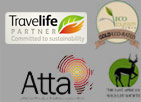The Okavango Delta is one of the world’s largest inland water systems. It’s headwaters start in Angola’s western highlands, with numerous tributaries joining to form the Cubango river, which then flows through Namibia (called the Kavango) and finally enters Botswana, where it is then called the Okavango.
Millions of years ago the Okavango river use to flow into a large inland lake called Lake Makgadikgadi (now Makgadikgadi Pans). Tectonic activity and faulting interrupted the flow of the river causing it to backup and form what is now the Okavango delta. This has created a unique system of water ways that now supports a vast array of animal and plant life that would have otherwise been a dry Kalahari savanna.
The delta’s floods are fed from the Angolan rains, which start in October and finish sometime in April. The floods only cross the border between Botswana and Namibia in December and will only reach the bottom end of the delta (Maun) sometime in July.
Taking almost nine months from the source to the bottom. This slow meandering pace of the flood is due to the lack of drop in elevation, which drops a little more than 60 metres over a distance of 450 kilometres. The delta’s water deadends in the Kalahari – via the Botetle river, with over 95 per cent of the water eventually evaporating.
During the peak of the flooding the delta’s area can expand to over 16,000 square kilometres, shrinking to less than 9,000 square kilometres in the low period. As the water travels through the delta, the wildlife starts to move back into the region. The areas surrounding the delta are beginning to try out (the rains in Botswana occur approximately the same time as in Angola) and the wildlife starts to congregate on the edge of the newly flooded areas, May through October.
The delta environment has large numbers of animal populations that are otherwise rare, such as crocodile, red lechwe, sitatunga, elephant, wild dogs, buffalo, wattled crane as well as the other more common mammals and bird life.
The best time for game viewing in the delta is during the May-October period, as the animal life is concentrated along the flooded areas and the vegetation has dried out.
The best time for birding and vegetation is during the rainy season (Nov.- April) as the migrant bird populations are returning and the plants are flowering and green.
Safari activities by water are the primary speciality of the Okavango – the mokoro – a dug out canoe which is ‘poled’ along by your Guide is the most evocative way of exploring the numerous waterways. Motor launches travel on the main waterways and lagoons.
Traditional 4×4 Game viewing vehicles are used on the main islands, with night drives available in the private concession areas – not allowed within the National Park.
Walking Safaris are available from most Camps and Lodges – perhaps the most exciting way of viewing Game – stalking and tracking wildlife with an expert Guide.
Game Viewing flights are available by both light aircraft and helicopter, but hot air ballooning is not allowed.
Perhaps the most marvelous way of exploring the Okavango is on the back of an Elephant.




